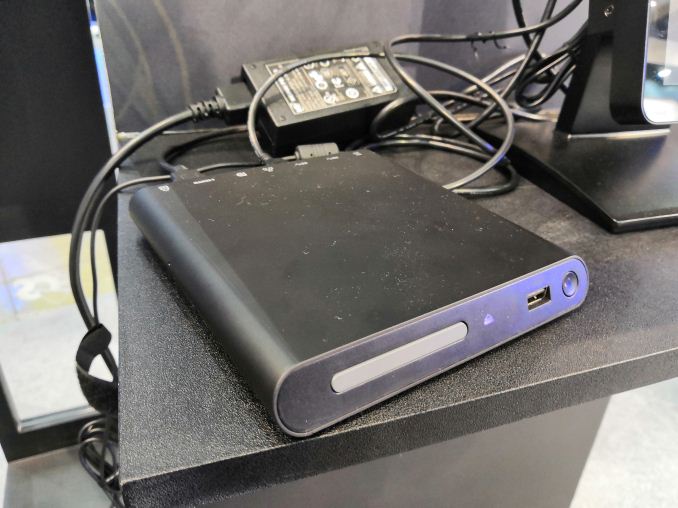ECS with Intel Compute Card: What Happened to Intel’s Compute Card?
by Ian Cutress on June 19, 2018 2:00 PM EST- Posted in
- Systems
- Intel
- Trade Shows
- Core M
- Compute Card
- Computex 2018

One of the more interesting and innovative platforms that Intel has introduced over the past few years was the Compute Card: a small credit-card like platform that contained a CPU, some memory, some storage, and a connector such that the card could be placed into all manner of docks and displays for a universal homogenous experience. The Compute Card arrived with much fanfare, but since then I have not heard much about it, let alone see one in real life. That changed with a visit to ECS at Computex.
ECS is one of Intel’s biggest engineering and manufacturing partners, taking on a lot of the Intel branded product contracts, such as the NUC. On display at their booth was the Intel Compute Card platform in two variants: first, a dock embedded in a touch screen display, and second as a dock that could be connected to a display. It’s that second one that interested me most.
Because the Compute Card is small, and super thin (it’s difficult to get over just how thin it is), the idea that you can take almost a full x86 computer with you to different points is pretty crazy. This is the point where someone mentions a smartphone, which I concede, but the Compute Card is so much smaller. The base design has either a Core-Y series processor or an Atom processor inside, and the dock provides the additional cooling and extension to things like networking, display, and USB. It’s like putting a credit card in a DVD drive hooked up to a monitor.
The one thing about when the Compute Card was launched that didn’t click immediately was the thermals. The docks in this case have to assist with the cooling – the thin metal chassis of the compute card is not enough, especially when the CPU can draw up to 6W. As a result, when a user needs to remove the Compute Card, they have to wait until the temperature decreases to something human friendly. Both myself and Anton commented that after ejecting the Compute Card, the temperature of the unit was quite toasty.
The dock ECS had on display was the DK132EPJ, or what Intel calls the ‘Port Jefferson’ platform. My ECS contact said, when I wanted to have a look at the Compute Card devices, ‘why do you want to look at something so old?’. The question itself kind of shows the two points about where the Compute Card stands today: not only have I not seen it up until now, it also has not been updated to the latest designs. It would seem that the power it provides is already sufficient for the markets its wants, or future products might be too power hungry for it.
Is the Compute Card a success? I don’t really know. If it’s taken me this long to even see one in person, then it’s either a ‘no’, or I’m just not following that market often enough. If one thing is for sure, there haven’t been any updates from Intel, which is a shame.
Edit: Imagine a cluster of these things: a dock that supports a hundred of them.
| Want to keep up to date with all of our Computex 2018 Coverage? | ||||||
 Laptops |
 Hardware |
 Chips |
||||
| Follow AnandTech's breaking news here! | ||||||















26 Comments
View All Comments
edzieba - Wednesday, June 20, 2018 - link
If you're hooking up a Compute Card to a monitor and KB&M, then you're missing the entire point. The purpose of the Compute Card is to be a standard form-factor for integration into other devices (e.g. the control computer for a tunneling microscope, the computer in a an ATM, etc) using a standard interface. The idea is that it allows what would otherwise be a static platform to be easily swapped out, avoiding the current issue where unsupported legacy platforms cling to operation because they're stuck to a device that has a longer lifetime.mode_13h - Sunday, June 24, 2018 - link
Two problems with this:1. If it's an Intel standard, that makes it unlike there'll be ARM versions.
2. Device makers don't have an incentive to embrace this, because it cuts out a significant part of their product and thus reduces selling prices. Lower selling prices -> less profit. And they have developed the capability to design and support their own embedded PCs, which means it'll face internal resistance. Worse yet, unless the compute cards become utter commodity items, the price of a device that supports them will probably go *up*, once you add in the cost of the card, itself.
The only way something like this gets momentum is if it's embraced by a bunch of upstart device makers, without a bunch of legacy. Then, the market could shift and you might see enough demand from customers to push other device makers to follow.
But I still think it'd be more compelling if it weren't coming from Intel, but rather a non-architecture specific industry consortium.
Finally, I don't know how good these things would be for robotics, but that's another application where I could see it being useful.
Gunbuster - Wednesday, June 20, 2018 - link
Would be a great solution for powering auto infotainment/nav/gauge clusters systems but they will never let that happen and kill one of their big profit centers.mode_13h - Sunday, June 24, 2018 - link
Yes, that's basically my point.roomN - Tuesday, July 3, 2018 - link
Some time ago I was very excited about Asus PadFone X - a smartphone which can be put into a tablet monitor. I thought it would have been great to be able to choose between those two screen sizes depending only on your current situation - what you can carry with you and the work you need to do with it.Now, I see the same idea at a much more mature level - Compute Card. You can put it into whatever screen you have.
It's a shame that people are so blind about new possibilities...
lazysummer7 - Monday, June 3, 2019 - link
Anyone had a look at this https://addc.net/products/biodigitalpc-11/